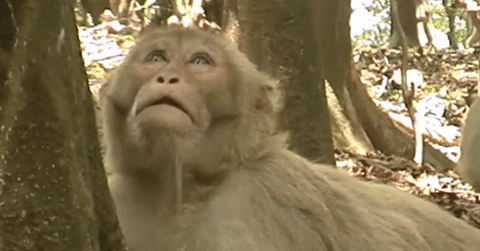Monkeys and humans share staring behavior

Following another's gaze is a hallmark of human learning and socialization from infancy to old age. Humans change how they follow gazes throughout life, and disruptions in the ability to follow someone's gaze are warning signs of autism and other social deficits.
Like humans, monkeys exhibit the same pattern of following another's gaze throughout their lives, suggesting the behavior is deeply rooted in our evolutionary past, according to a new study led by researchers at Yale, Harvard, and University of Pennsylvania.
"Gaze-following is a crucial developmental pathway, which lays foundation for acquiring language and interacting socially," said Laurie Santos, Yale psychologist and senior author of the study published online May 11 in the Proceedings of the Royal Society B. "Here we find that gaze-following emerges in the same way in a species with an entirely different life history."
Along with Alexandra Rosati of Harvard and Michael Platt of UPenn, Santos and colleagues tested how 481 rhesus monkeys living in a preserve responded to the upward glance of a researcher. As with most human babies, infant monkeys began gaze-following from a very early age. However, they tended to take more looks than human babies do to find out what the researcher was looking at, even after three or four glances revealed nothing of interest. By their juvenile years, monkeys became more flexible in their gaze-following and became habituated to repeated gazes over time. During adulthood, monkeys' responses were more varied, and they began showing human-like sex differences, with females responding to gazes more than males. Older monkeys—like older humans— then became less sensitive to gaze cues overall.
Santos said this is the first study to show such a close relationship between social development in humans and monkeys. Testing such a large number of monkeys will also enable this team to study individual behavioral and genetic variations between animals, she said.
These results provide exciting new evidence that monkeys' social attention follows a remarkably human-like trajectory across age groups, said the researchers.
"Monkeys have different social experiences than humans, grow up much faster than we do, and do not share features of human aging such as menopause—yet they show the same changes as humans in this foundational social skill from infancy to old age" said Rosati, lead author of the study.
These findings suggest that some social capacities such as gaze following may have a deeper biological basis than previously thought, Rosati said.
More information: Rhesus monkeys show human-like changes in gaze following across the lifespan. DOI: 10.1098/rspb.2016.0376
Journal information: Proceedings of the Royal Society B
Provided by Yale University



















